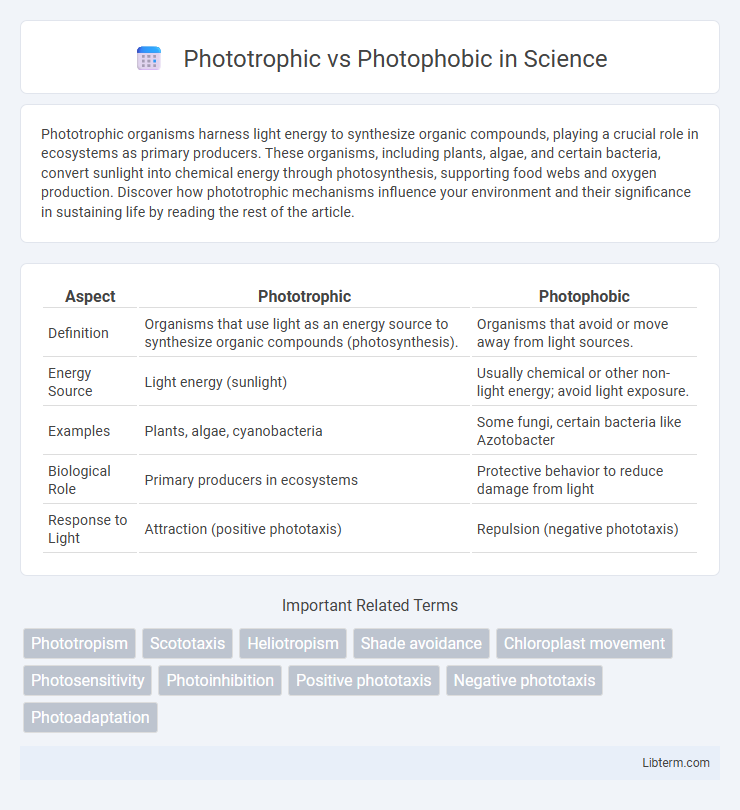Phototrophic organisms harness light energy to synthesize organic compounds, playing a crucial role in ecosystems as primary producers. These organisms, including plants, algae, and certain bacteria, convert sunlight into chemical energy through photosynthesis, supporting food webs and oxygen production. Discover how phototrophic mechanisms influence your environment and their significance in sustaining life by reading the rest of the article.
Table of Comparison
| Aspect | Phototrophic | Photophobic |
|---|---|---|
| Definition | Organisms that use light as an energy source to synthesize organic compounds (photosynthesis). | Organisms that avoid or move away from light sources. |
| Energy Source | Light energy (sunlight) | Usually chemical or other non-light energy; avoid light exposure. |
| Examples | Plants, algae, cyanobacteria | Some fungi, certain bacteria like Azotobacter |
| Biological Role | Primary producers in ecosystems | Protective behavior to reduce damage from light |
| Response to Light | Attraction (positive phototaxis) | Repulsion (negative phototaxis) |
Introduction to Phototrophic and Photophobic Organisms
Phototrophic organisms obtain energy through photosynthesis by absorbing light, primarily using pigments such as chlorophyll to convert solar energy into chemical energy. Photophobic organisms exhibit aversion or movement away from light sources to avoid potential damage from excessive illumination or UV radiation. Understanding the mechanisms of phototrophy and photophobia reveals diverse adaptations in microorganisms, plants, and animals related to light detection and energy utilization.
Defining Phototrophy: Harnessing Light for Growth
Phototrophy is the biological process by which organisms capture and convert light energy into chemical energy to fuel their growth and metabolic activities. Phototrophic organisms, such as plants, algae, and certain bacteria, use pigments like chlorophyll to absorb sunlight and drive photosynthesis, producing organic compounds essential for cellular function. In contrast, photophobic organisms exhibit aversion to light, often moving away from it to avoid damage or desiccation, highlighting a behavioral adaptation distinct from the energy-harvesting mechanism of phototrophy.
Photophobia Explained: Avoidance of Light Stimuli
Photophobia is characterized by an abnormal intolerance or sensitivity to light, causing discomfort or pain in the eyes when exposed to bright or intense light stimuli. Unlike phototrophic organisms that are attracted to light for energy or biological processes, individuals with photophobia actively avoid light sources to prevent symptoms like headaches, eye strain, or nausea. This aversion to light is often linked to underlying conditions such as migraines, eye infections, or neurological disorders, highlighting the importance of managing light exposure in affected individuals.
Key Differences between Phototrophic and Photophobic Behavior
Phototrophic organisms exhibit positive movement toward light sources to maximize photosynthesis efficiency, while photophobic organisms demonstrate avoidance behavior by moving away from light to prevent damage from excessive exposure. Phototrophic responses are commonly observed in plants and algae that rely on light for energy production, whereas photophobic behavior is typical in organisms such as certain bacteria and insects seeking shelter or maintaining optimal living conditions. The key difference lies in the directional response to light stimuli: attraction in phototropic behavior versus repulsion in photophobic behavior.
Evolutionary Perspective on Light Response
Phototrophic organisms evolved to harness light energy for photosynthesis, allowing them to convert solar energy into chemical energy critical for survival and growth, driving ecological dominance in many environments. Photophobic species developed mechanisms to avoid or minimize light exposure, often as an adaptive response to harmful radiation or oxidative stress, enhancing their survival in low-light or fluctuating habitats. Evolutionarily, these divergent light responses illustrate selective pressures shaping sensory and metabolic pathways to optimize energy acquisition or protection from photodamage.
Ecological Roles of Phototrophic vs Photophobic Organisms
Phototrophic organisms, such as algae and cyanobacteria, play a crucial ecological role by converting sunlight into chemical energy through photosynthesis, thereby producing oxygen and supporting aquatic food webs. Photophobic organisms actively avoid light to reduce predation risk and prevent desiccation, often inhabiting shaded or nocturnal environments where they contribute to nutrient cycling and ecosystem stability. The contrasting behaviors of phototrophic and photophobic species maintain ecological balance by optimizing energy flow and habitat utilization across diverse ecosystems.
Phototrophic Adaptations in Various Environments
Phototrophic organisms exhibit specialized adaptations to optimize light absorption and energy conversion, such as chlorophyll pigments and specialized light-harvesting complexes that enhance photosynthesis efficiency. These adaptations vary across environments, with aquatic phototrophs utilizing accessory pigments to capture different light wavelengths underwater, while terrestrial phototrophs develop leaf morphologies and chloroplast arrangements to maximize light exposure. In extreme habitats like deserts or deep-sea vents, phototrophic species adapt by producing protective pigments against UV radiation or by utilizing low-intensity light sources to sustain energy production.
Photophobic Mechanisms and Survival Strategies
Photophobic organisms exhibit avoidance behaviors triggered by intense light to prevent cellular damage from ultraviolet radiation and oxidative stress. Their survival strategies include the synthesis of photoprotective pigments such as carotenoids and mycosporine-like amino acids, alongside efficient DNA repair mechanisms like nucleotide excision repair and photoreactivation. These mechanisms enable photophobic species to thrive in fluctuating light environments by minimizing photooxidative damage and maintaining cellular homeostasis.
Applications in Biotechnology and Research
Phototrophic organisms harness light energy for growth, making them essential in biotechnology for biofuel production, carbon fixation studies, and sustainable bioprocessing. Photophobic organisms, which actively avoid light, are valuable in research on light-sensitive signaling pathways and in developing biosensors responsive to environmental light changes. Understanding the phototrophic and photophobic responses enables innovative approaches in synthetic biology, agricultural biotechnology, and environmental monitoring.
Future Directions in Studying Light-Responsive Behaviors
Future research on phototrophic and photophobic behaviors will benefit from advanced optogenetic tools that enable precise manipulation of light-sensitive proteins, allowing deeper insights into cellular signaling pathways. Integration of high-resolution imaging with machine learning algorithms promises to unravel complex behavioral patterns in response to varying light intensities and wavelengths. Emerging applications in synthetic biology aim to engineer organisms with enhanced or novel light-responsive traits for environmental and biomedical innovations.
Phototrophic Infographic

 libterm.com
libterm.com